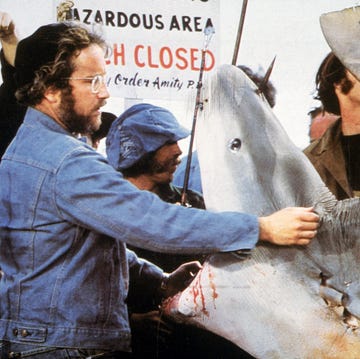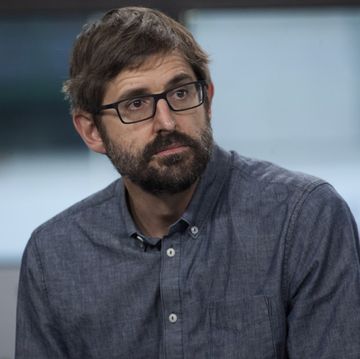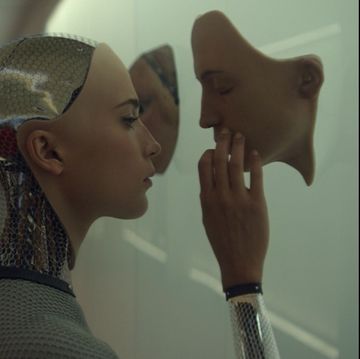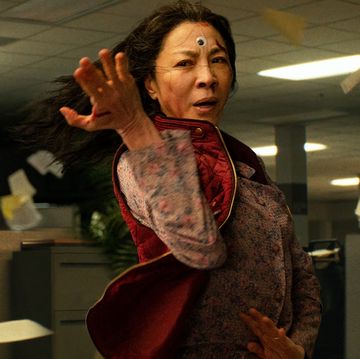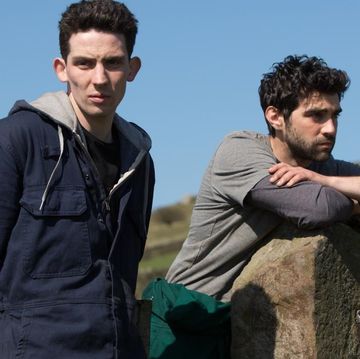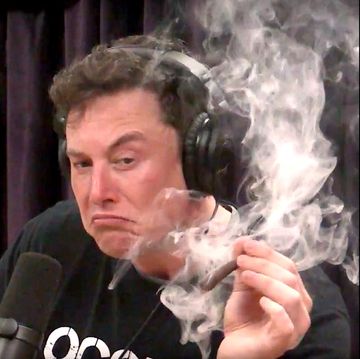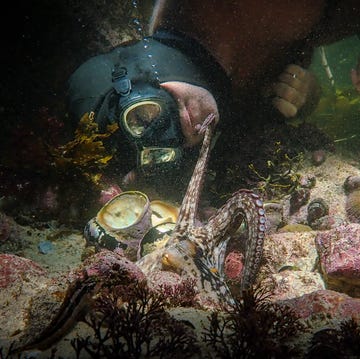The galleries are shut, the museums are closed. But worry not, art fans. We've tapped some of the art world's leading curators, collectors and experts to talk us through the exhibitions none of us can attend in person. Here Nicholas Cullinan, director at the National Portrait Gallery, talk us through his highlights from its blockbuster show, David Hockney: Drawing From Life.
My Parents and Myself (1976)
David Hockney was born in Bradford, West Yorkshire. His father worked as a clerk, but was an amateur artist and anti-smoking campaigner (which is somewhat ironic, given his son’s later, very vocal position on this issue), who was well-known for his strong political views. Laura Hockney was a quieter but strong matriarchal figure, a vegetarian and committed Methodist.
Hockney was visited by his parents whilst he was living intermittently in Paris (1973-5). It was there that he made the preparatory drawings and took reference photographs for the planned painting. My Parents and Myself is an earlier version of My Parents, in Tate’s collection. In the later painting, Hockney replaced his self-portrait – reflected in the mirror – with a postcard of The Baptism of Christ by Piero della Francesca (c.1415/20 –1492), a painting he admired. My Parents and Myself represents some of the key themes explored in the exhibition – intimate relationships, working from life and the influence of other artists. While selecting the works for the Drawing from Life exhibition at the National Portrait Gallery in his Los Angeles studio, Hockney rediscovered the painting, believing that after abandoning it, the work had been destroyed.
Self Portrait (1954)
As a schoolboy, Hockney had a passion for art, even before he fully understood what it meant to be an artist. An academic training at Bradford School of Art provided the foundation for his career, with its emphasis on drawing, painting and the study of anatomy and perspective. Inspired by the first art books he saw, initially in black and white, and then in colour, his early influences ranged from Piero della Francesca to Pierre Bonnard.
Hockney has always been a confidant draughtsman. Like most young artists, his subjects were himself, those close to him, and his immediate surroundings; domestic interiors and the local landscape. These interests have remained with him throughout his working life; he still draws on every available piece of paper and his creative mind never rests.
This self-portrait, a collage using newspaper and made when Hockney was seventeen, conveys a youthful confidence, a sense of himself as an artist, as well as the beginning of an intense self-scrutiny. It also offers a foretaste of what was to come stylistically in the artist’s vibrant use of colour and experimentation with different media.
Self Portrait (26 Sept 1983)
In the autumn of 1983, almost every day for two months, Hockney challenged himself to produce a candid self-portrait in charcoal. This period of intense self-reflection was, in part, a reaction to the untimely deaths of many of his friends due to the HIV/AIDS epidemic. The honesty and vulnerability exposed in these drawings is a far cry from the confident self-portraits of 30 years earlier. Like the pages of a diary, these works record the daily changes in the artist’s moods and emotions.
No. 1201 (14 March 2012)
Over the last decade or so, Hockney – who has always experimented with different mediums and technologies – has made a series of self-portraits made using the technology developed for iPads. Hockney employed the screen like a sketchbook, as a window with infinite possibilities for colour and mark-making. In 2012, the artist made a digital self-portrait every day over the course of 20 days, exploring character types and facial expressions inspired by sketches by the Old Masters, such as Rembrandt.
Mother, Bradford (19 Feb 1979)
After the artist’s father died, Hockney made two drawings of his mother in sepia ink and using reed pens, as Van Gogh had done in his own portraits. Using a minimal line, Hockney conveys the sadness in his mother’s face as she looks directly at her son. Making a drawing was less intrusive than taking a photograph would have been – drawing had become Hockney’s way of communicating intimately and compassionately with his mother.
Celia, Carennac (August 1971)
Textile designer, Celia Birtwell, has been a dear friend and close confidante to David Hockney since the Sixties. With their northern roots and shared sense of humour, they found they had much in common from their first meeting and together they were at the heart of bohemian London. Hockney has always been fascinated by the changing nature of Celia’s face, and she remains, to this day, one of his favourite models.
Although often described as Hockney’s ‘muse’, their relationship is much more than that. They have always admired each other’s work and her sittings for him have been collaborations, as well as an opportunity to enjoy each other’s company. In his portraits of Celia, the artist has always paid close attention to her distinctive and romantic fabric designs, some of which are inspired by his work. She says: "David has his own opinions and has always gone against the grain. He wants his work to speak for him more than anything else in the world. He’s a true artist."
Gregory, Palatine, Roma (Dec. 1974)
Gregory Evans and David Hockney have been close friends for fifty years and, together with Celia Birtwell and Maurice Payne, he remains a consistent model. Gregory met the artist in London through the Los Angeles art dealer, Nick Wilder. They began an intimate relationship in Paris in 1974, when both lived on the left bank of the Seine: Gregory at rue de Dragon and the artist a short walk away at Cour de Rohan. Gregory’s role has evolved from lover and studio assistant to curator and trusted adviser.
Gregory has been the artist’s travelling companion in Europe and further afield. This drawing was made in Rome early in their relationship. Hockney uses a spare, unbroken line in pen and ink to capture his fascination with his new lover.
Gregory. Los Angeles (31 March 1982)
Hockney has always had an interest in experimenting with different mediums, and in the Eighties made a series of works with Polaroids and photographs of a sitter collaged together (here in a grid) to create a Cubist portrait.
Maurice (1998)
Master printer Maurice Payne’s lifelong friendship with the artist began in London in the mid-Sixties, when they worked together on the etching suite, Illustrations from Fourteen Poems from CP Cavafy (1967). They continued to collaborate on significant print projects until the late Seventies.
In 1998, after a period of 20 years, they worked together again when Maurice set up a print studio in Los Angeles. To encourage the artist, he would take the prepared etching plates up to Hockney’s house in the Hollywood Hills and then take them back down the hill to print on a press he set up at Hockney’s studio in West Hollywood. Working from life, Hockney drew still lifes and portraits of his friends. At the time Hockney was painting monumental landscapes of the American West in his studio, while making these intimate portraits in the domestic setting of his home
Maurice encouraged the artist to work in an innovative way. Hockney’s characteristic line, so well suited to the etching process, is combined with using unusual tools such as a wire brush to create texture and volume. The influence of Van Gogh can be seen in the mark making as well as the full-frontal pose of the master printer.
Though the National Portrait Gallery is currently closed, the show's catalogue – David Hockney: Drawing From Life – is available now.
Like this article? Sign up to our newsletter to get more delivered straight to your inbox
Need some positivity right now? Subscribe to Esquire now for a hit of style, fitness, culture and advice from the experts










